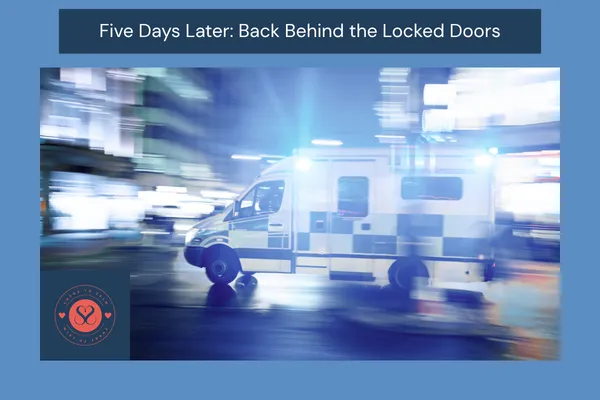
Five Days Later: Back Behind the Locked Doors
Five Days Later: Back Behind the Locked Doors

When “safe to go home” lasts less than a week.
Content warning: Mentions of self-harm and suicidal thoughts.
She came home on a Monday.
By Friday, we were back in crisis.
Five days. That’s all it took.
But honestly, it had started long before that.
The weekend “trial run”
The weekend before discharge, she was allowed to go home for a day, which is called home leave. It was supposed to be a positive step, a chance to “test” how she’d manage outside the unit. I remember feeling uneasy as soon as it was suggested. My gut said it was too soon.
But the professionals were pleased with her progress: “She’s engaging well,” “Her mood’s stable,” “She’s talking to staff.” They only see what’s in front of them. They don’t see what happens the moment she’s out of their sight.
She came home that Saturday, and from the moment she walked through the door, the atmosphere shifted. You could feel the tension sitting on her shoulders. The world outside the ward is too big for her when she’s fragile, too many triggers, too much freedom, too much noise.
Within hours, it started to unravel. She withdrew. Stopped eating. Stopped talking. The old signs came creeping back, the restless pacing, the long showers, the distant stare that means her head’s filling with dark thoughts again.
By evening, she’d had enough. She picked up the phone herself and called the unit. Calmly told them she couldn’t do it, that she needed to come back. So the “home leave” that was meant to last the weekend ended that same night.
It should have been a warning sign. A flashing red light that said, not ready. But somehow, it wasn’t treated like that at all.
The next morning, I rang the unit. Told them straight: “This was a disaster. She’s not ready. Please don’t discharge her and make my feelings known on record".
They tried to reassured me. “It’s okay, it’s just nerves. We’ll keep an eye on her.”
The discharge that shouldn’t have happened
On the Monday, they called to say she’d be discharged that day. I could barely get my words out: “Are you sure? Did you read my message? Did anyone actually see how she was at home?”
They said she’d been calm, polite, co-operative, that she “seemed fine.” And there it is again: the most dangerous phrase in the mental-health system — seems fine.
She masks everything. She’s learned to. She’s been taught that showing emotion leads to restraint, medication, or being misunderstood. So she smiles, she nods, she says the right things and everyone mistakes that for stability.
When I arrived to collect her, I asked the nurse one last time if they were certain. She looked at me, kind but tired, and said, “We have to follow what the doctors decide.”
And just like that, she was discharged.
We drove home in silence. She was polite, distant, flat. By that evening, she’d already retreated to her room. The first night was tense, she didn’t sleep, and neither did I. I kept thinking, If they hadn’t discharged her, this wouldn’t be happening.
Five days later
By Friday, it all collapsed.
She stopped eating. Stopped speaking. Started scratching again. I could see her slipping, but she was calm, too calm and that’s what makes it terrifying. She internalises everything until it explodes inward.
The crisis team rang several times that day asking for my view, how bad was it, when was she last seen by the community nurse, what did I think might happen if she wasn’t admitted? Her mental health nurse and I told them bluntly: If she’s not admitted tonight, she won’t make it through the weekend.
By evening, it was all in motion. Two psychiatrists, a senior mental-health nurse, and a private ambulance arrived. They’d clearly been briefed, they knew she was calm but unsafe. They spent over an hour with her, speaking gently, explaining everything, giving her every chance to agree voluntarily.
She refused. Quietly, but firmly. “I’m not going back,” she said. “I just want it to stop.”
That’s the moment you know, not when they shout, but when they give up fighting.
So she was sectioned again.
Watching her walk out to that ambulance, calm, compliant, broken, will stay with me forever. The same routine, the same hospital smell, the same hollow sound of the doors closing behind her. Relief and heartbreak, tangled together.
What I can’t let go of
If she hadn’t been discharged, none of this would have happened.
That home leave should never have gone ahead. The discharge should never have been signed off. The risk was obvious to anyone willing to look beneath the surface.
But the system doesn’t reward caution; it rewards boxes ticked. “Eating,” tick. “Engaging,” tick. “Says she feels better,” tick.
No space for a mother’s gut feeling. No line for “still terrified she’ll die.”
This isn’t care. It’s crisis management.
It’s about freeing beds, not finding safety.
It’s about reacting after the fact, instead of preventing the fall.
What helped me survive the week
I stopped pretending to be fine. The night she was readmitted, I felt empty. Then I got up and fed the dogs. Sometimes “functioning” is just breathing between breakdowns.
I wrote everything down. Every call, every visit, every time someone contradicted the previous plan. It’s the only way to stay sane when the system gaslights you with paperwork.
I reached out. One friend. One message. “She’s back in.” No detail, no drama, just connection. That helped more than any hotline ever has.
Five days.
That’s all it took for “safe to go home” to unravel.
She’s back behind the locked doors now, and I’m both broken and relieved. Because I know, deep down, that this time she’s where she needs to be, not because she’s fixed, but because she’s alive.
Your calm in the chaos,
Sami xx
